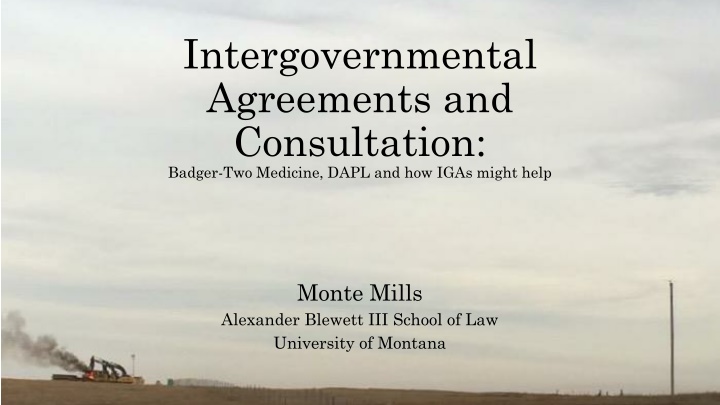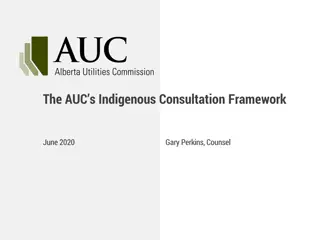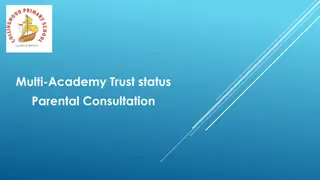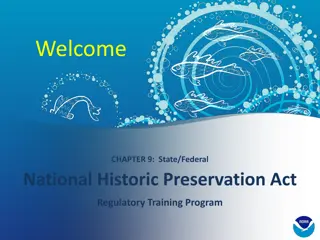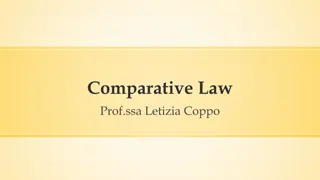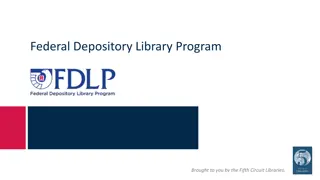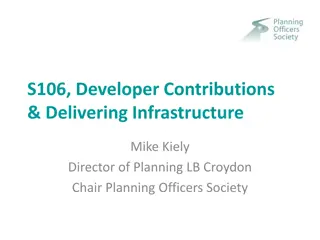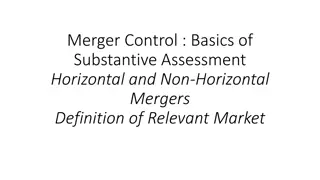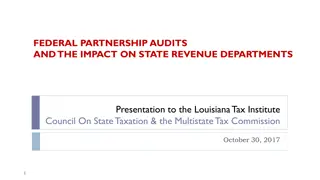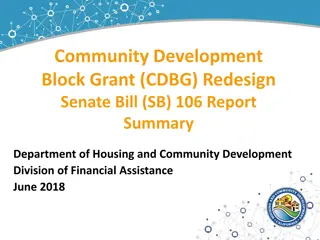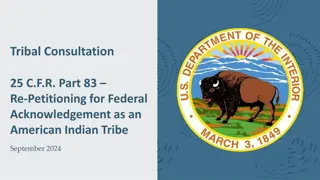Consultation in Federal Undertakings: IGAs and the 106 Process
This content discusses intergovernmental agreements (IGAs) and consultation processes in federal undertakings, focusing on their impact on properties of cultural or religious significance to Indian tribes. It explores the importance of the 106 Process and the obligations of federal agencies under the National Historic Preservation Act (NHPA).
Download Presentation

Please find below an Image/Link to download the presentation.
The content on the website is provided AS IS for your information and personal use only. It may not be sold, licensed, or shared on other websites without obtaining consent from the author.If you encounter any issues during the download, it is possible that the publisher has removed the file from their server.
You are allowed to download the files provided on this website for personal or commercial use, subject to the condition that they are used lawfully. All files are the property of their respective owners.
The content on the website is provided AS IS for your information and personal use only. It may not be sold, licensed, or shared on other websites without obtaining consent from the author.
E N D
Presentation Transcript
Intergovernmental Agreements and Consultation: Badger-Two Medicine, DAPL and how IGAs might help Monte Mills Alexander Blewett III School of Law University of Montana
The 106 Process as Consultation The National Historic Preservation Act (NHPA) defines undertaking as: a project, activity, or program under the direct or indirect jurisdiction of a Federal agency, including (3) those requiring a Federal permit, license, or approval (54 U.S.C. 300320) The NHPA also requires that a federal agency consider the effects of such undertakings on property of cultural or religious significance to Indian tribes and consult with tribes about such properties. Id. at 306108, 302706(b).
IGAs in the 106 Process 1. Where an undertaking will have adverse effects on an eligible property, but the parties consult and agree on a resolution for such adverse effects, they shall enter into a memorandum of agreement that will govern the undertaking. 36 C.F.R. 800.6. 2. Agencies can develop program alternatives to 106 process. These include programmatic agreements, which may be used : (i) When effects on historic properties are similar and repetitive or are multi-State or regional in scope; (ii) When effects on historic properties cannot be fully determined prior to approval of an undertaking; (iii) When nonfederal parties are delegated major decisionmaking responsibilities; (iv) Where routine management activities are undertaken at Federal installations, facilities, or other land management units; or (v) Where other circumstances warrant a departure from the normal section 106 process. 36 C.F.R 800.14.
federal agencies must make reasonable and good faith efforts to identify tribes that should be consulted and their concerns about the undertaking, including an awareness that historic properties of religious and cultural significance may be located off tribal lands on ancestral, aboriginal, or ceded lands. An agency's failure to engage in a reasonable and good faith effort to identify historic properties of religious and cultural significance to a tribe is a violation of the NHPA. Consistent with the requirements of 36 C.F.R. 800.7(c)(4), BLM has reviewed ACHP's final comments and the Secretary of Agriculture's recommendation. BLM does not believe there is a basis for a memorandum of agreement to protect or mitigate impacts to the TCD properties and values associated with lease development. Therefore, BLM finds that the TCD will be adversely affected if the development contemplated under Lease No. MTM53323 is allowed. Accordingly, BLM concludes that Solenex's APD should be disapproved and Lease No. MTM53323 should be cancelled. - BLM letter to Solenex, March 17, 2016.
We urge the Corps to consider expanding its review of this undertaking by redefining the area of potential effects (APE) consistent with 36 CFR Section 800.16(d) of our regulations, Protection of Historic Properties (36 CFR Part 800). Furthermore, to ensure that the Corps fully meets its Section 106 compliance responsibilities, we recommend that you consider developing a programmatic agreement to address this complex undertaking in accordance with 36 CFR Section 800.14(b). -ACHP to USACE, March 15, 2016 It is our recommendation that the Corps and the FWS coordinate with consulting parties to develop a comprehensive PA to address varying federal jurisdiction and authority over components of the DAPL Project, expansion and completion of an appropriate identification effort, phasing of the steps of the Section 106 process that will facilitate tribal assistance in identification of properties of concern to the tribes, and responsibility for effects to historic properties in portions of the undertaking outside FWS easements and in uplands between crossings of the WOUS under Corps jurisdiction. -ACHP to USACE, May 19, 2016
We continue to disagree with the Corps findings regarding effects on historic properties and believe a comprehensive Programmatic Agreement (PA), as we recommended to Lieutenant General Bostick, be developed. The Corps should consider how the information gathered by Energy Transfer, as well as the information submitted to the Corps by the Indian tribes, could be used to support the PA. Such a PA could address multiple procedural issues including the following: Recognition of varying jurisdiction and authority over components of the DAPL Project; Completion of an appropriate identification effort and analysis of effects; Phasing of the Section 106 reviews to facilitate tribal assistance in identification of properties of concern to the tribes; and Consideration of effects to historic properties in portions of the undertaking outside the Corps jurisdiction. We look forward to assisting the Corps in this endeavor should it choose to resolve our objection by developing such an agreement. However, we recognize that, per 36 CFR 800.5(c )(3) of our regulations, the final decision regarding the effects on historic properties is the responsibility of the Corps. -ACHP to USACE, June 2, 2016
USACE Response: We have a PA and that s what we ve followed:
So, now what? 2) Identifying Any Necessary Change to the Existing Framework. Where and when does the current framework present barriers to meaningful consultation? What changes to the current framework would promote these goals? This category of questions includes potential change to regulations, policies, and procedures, as well as statutory changes that would increase timely and meaningful consultation.
Thank you! Monte Mills monte.mills@umontana.edu 406.243.2544
